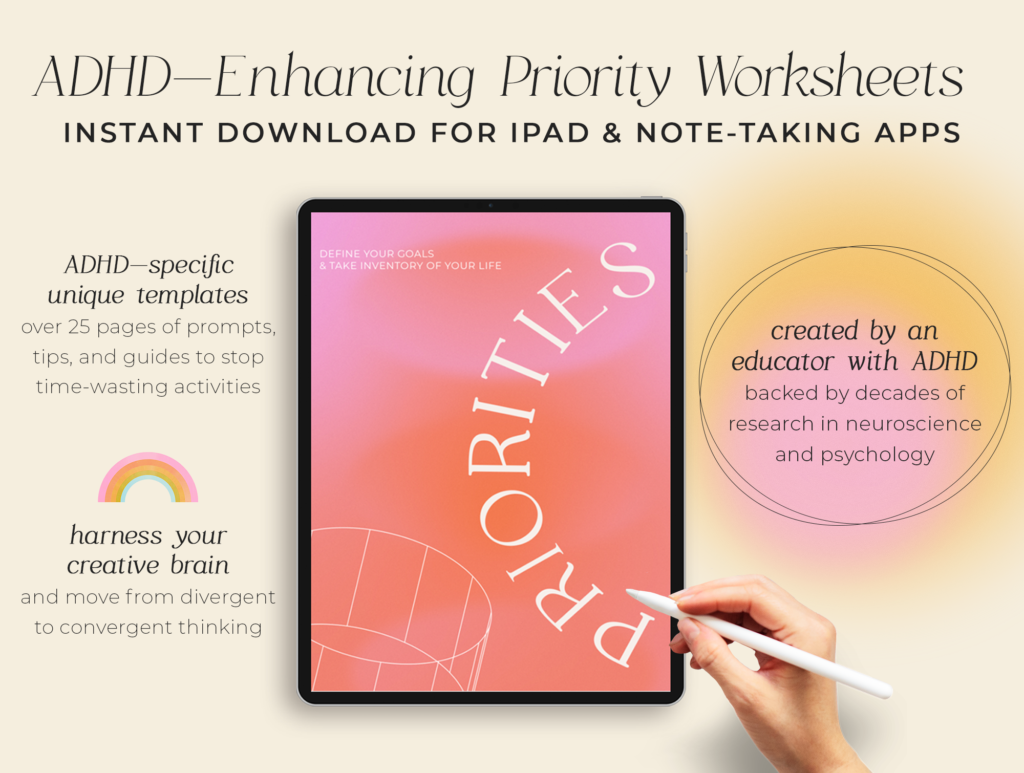Have you ever started to do something that you thought would only take five minutes, only to get completely side-tracked for four hours? That, my fast-brained friend, is the very real phenomenon known as “time blindness.” It’s one of the most common symptoms of ADHD and can negatively affect your work, social life, and household tasks.
the cognitive processes necessary to be a functional human in modern society are called “executive functions.” One of the most challenging executive functions for ADHDers is “sense of time.” Time blindness is what happens when your ADHD brain is so completely absorbed in a task that you lose complete track of time. It’s not because we’re lazy, or that we lack ambition, or that we are disrespectful, it’s that we literally don’t feel time passing.
Simply put, our brains are simply wired differently and so we often only experience time and “now” and “not now.” It also leads to the feeling that time is passing by without being able to complete tasks accurately or well enough. At best, it keeps you sucked into a task longer than you expected. At worst, it can derail your whole day, week, or life. It can keep you from ever making progress on the goals that actually matter to you.
So here’s your permission to stop beating yourself up. Good time management is based on the ability of being aware of time. You can’t be good at time management if you are bad at predicting how long something is going to take. If your struggle with time blindness has led you astray in the past, it’s not from lack of trying, it’s because you didn’t have the awareness.
This all sounds depressing AF. But the good news is that when treated, whether with time awareness techniques, coaching, and/or medication, coaching, people with ADHD can in fact develop a normal sense of time. Keep reading for solutions to “beat” time blindness and start living your life.
How To Stop Being So Busy
When it comes to hacking time blindness, not all advice is good advice, even if it comes from well-meaning, but totally uninformed friends or family. Sometimes ill-informed advice even comes from medical experts who aren't trained in ADHD. I tried (and failed) many times to get a grip on time blindness before finally figuring out what works. Here’s a suggestion that absolutely didn’t work:
The Worst Advice For Time Blindness
“If it only takes a minute, do it now.”
When your intention is to run around all day like a chicken with your head cut off, go ahead and follow that advice. If, like me, you’re tired of letting ADHD run the show, stop adding so many transitions to your day.
Anytime you think to yourself “this will only take a minute!” Give yourself a little pinch. Not literally, but you know what I mean. Humans – especially those of us with ADHD – trick ourselves into completing non-essential tasks in order to avoid doing more important work.

How To Start Living Your Life
We set ourselves up for failure when we try to squeeze our work into a checklist based on flawed time estimates. The things we avoid are usually activities that will actually move the needle, like strategizing, creating, or deep thinking.
Instead of relying on endless to-do lists, we can prioritize our days to achieve peak performance. First decide your macro life goals (job promotion, new title, new business, investment, etc.) and create mini goals to move you forward (complete a project on time, prepare a salary negotiation, plan a marketing strategy). Distracting thoughts will come up, but dumping and moving on will keep you moving towards the finish line.
Make Time More Visible
Because we have difficulty estimating how long things will take, one of the key aspects of ADHD training is making time more visible, literally. Here are two ways you can do that:
- Wear an analog wrist watch. I know, I know, that sounds childishly simple. But hear me out, wearing a watch on your wrist removes the friction of having to find your phone (sometimes a difficult enough task as it is) and press a button to check the time. If it’s always on your wrist, all you have to do is look at it. And analog is better than digital because seeing the ticking hands gives your brain the sense that time is passing. A digital watch doesn’t have that same effect. Unless it also counts down seconds, it’s a lot more abstract.

- Use physical timers. I like the minimalist, vintage aesthetic of this one. But if you’re not crazy like me, this one works perfectly well. Yes, these are the kinds of timers used by elementary school teachers in classrooms everywhere, but for good reason! Like little kids, our sense of time is still developing. Having that physical symbol of the time window getting smaller and smaller is extremely helpful. The ringing at the end signals that it’s time to move on to another task.
I know I’ve painted time-blindness in a bad light, but it’s not always a bad thing. When you pair time-blindness with ADHD hyperfocus, neurodivergent brains can produce remarkable results. As long as it’s not interfering with any other obligations, have at it!
“Beat” time-blindness: 9 Practical Tips
- Schedule your priorities, not your time. If you don’t prioritize your own time, someone else will, be it your friends, your family, your boss, or some random chick on Instagram who lives on egg yolks and beef liver. This is the most important time management advice not enough people are talking about.
Good time management is not getting to “inbox zero.” If you’re not clear on what your priorities even are, everything will feel equally important. You’ll spend your entire morning doing the less important things and never getting to the to-do’s you intended. But here’s the truth: You will never cross everything off your to-do list. The sooner you can accept that, the sooner you’ll be able to effectively manage your time. I highly recommend reading the book Four Thousand Weeks: Time Management for Mortals by Oliver Burkeman. And if you want some more awesome ADHD-enhancing book recommendations, check out this post!
I created a priority planner specifically for ADHD brains, backed by neuroscience and psychology. It’s more than just a planner, but a guide to figuring out what matters most and how to schedule your time around it. Forgive the shameless plug, but my mission is to help people get a grip on their ADHD, no matter how severe it is. This coming from someone who thought she was a “lost cause.” If I can figure it out, you can, too. If you’re not feeling the planner, check out this priority mindset exercise instead (based on advice from self-made billionaire investor Warren buffet!).

Not sure if digital planning is your thing? Read about why digital is better than paper for ADHD and try out a FREE planner here!
- Use block scheduling to plan your day. There’s a reason you never cross everything off your to-do list: there’s no time limit attached to the items. Instead of making a list of things you need to do (which is infinite), use a block or hourly schedule to map them out.
It’s easy to get distracted doing laundry if your list looks like this:

But planning your like this makes it more obvious what you actually have time for and when:

- Set frequent reminders and alarms. Sounds simple, but it’s way easier to succumb to time-blindness if you don’t have a tool to snap you out of it. It’s easy to get sucked into things for too long, so an annoying alarm going off is a surefire way to bring you back to reality.
- Remember the mantra: done is better than perfect. Sometimes we get sucked into an activity too long when we’re trying to make it perfect, but striving for perfection in all that we do is time-consuming and unrealistic. So remember this mantra. You can always come back and make improvements to something if you shave off some time elsewhere in your day.
- Delegate time-consuming tasks that don’t turn you on. Sometimes time blindness results from procrastinating the things we don’t want to do. So we end up actively working on a less important task in order to avoid the more important one. So here’s where some of life’s greatest advice comes in: If someone else can do it for you, let them do it! Yes, it often comes with a financial cost involved, but your time is valuable. So decide where you can afford to hand off unwanted tasks and use your time more effectively to make up the difference.
- Get in the habit of using a “brain dump” page. No matter how you slice it, crossing off “RSVP to Janet and Bill’s 50th wedding anniversary” just isn’t as important as “finish the report due tomorrow,” or “plan social media strategy,” but it feels so satisfying. Instead, write that shit in a “brain dump” page or section of your priority planner and keep at your original task until the timer goes off. Distracting thoughts will come up, but dumping and moving on will keep you moving towards the finish line.
- Schedule social media time. One of the biggest time-sucks for me was social media. My job is entirely online so it wasn’t feasible to delete social media apps altogether, (but if you can, DO IT!) but I notice my day is a lot more productive when I only check TikTok or Instagram at scheduled times. Twice a day seems to be the magic number for me!
- Delete shopping apps and/or schedule shopping time. Another time suck for me was online shopping. I would turn on my computer to look for one item but I would get distracted, either by choice paralysis (too many options online) or impulse shopping and would end up doing some major damage (to my schedule and wallet). Even something as simple as online grocery shopping could keep me sucked in for hours. The solution I came up with was to add everything to a wish list when it popped in my head and then once a week or once a month, I review my wish list and see what I actually still need/want. Then I block off time in my schedule to do said shopping, making sure to set a timer so I don’t go over on time. For shopping, it’s also important to have a budget in mind.
- Schedule “me” time. Another reason we end up getting sucked into a low-priority task is that we never make ourselves a priority. If you never give yourself time to do a face mask, scroll aimlessly on social media, read a book, you’re going to end up doing it at inconvenient times.
Comments +